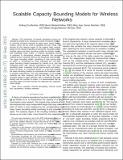Scalable Capacity Bounding Models for Wireless Networks
Author(s)
Jinfeng Du; Medard, Muriel; Ming Xiao, Muriel; Skoglund, Mikael
DownloadMedard_Scalable capacity.pdf (468.2Kb)
OPEN_ACCESS_POLICY
Open Access Policy
Creative Commons Attribution-Noncommercial-Share Alike
Terms of use
Metadata
Show full item recordAbstract
The framework of network equivalence theory developed by Koetter et al. introduces a notion of channel emulation to construct noiseless networks as upper (respectively, lower) bounding models, which can be used to calculate the outer (respectively, inner) bounds for the capacity region of the original noisy network. Based on the network equivalence framework, this paper presents scalable upper and lower bounding models for wireless networks with potentially many nodes. A channel decoupling method is proposed to decompose wireless networks into decoupled multiple-access channels and broadcast channels. The upper bounding model, consisting of only point-to-point bit pipes, is constructed by first extending the one-shot upper bounding models developed by Calmon et al. and then integrating them with network equivalence tools. The lower bounding model, consisting of both point-to-point and point-to-points bit pipes, is constructed based on a two-step update of the lower bounding models to incorporate the broadcast nature of wireless transmission. The main advantages of the proposed methods are their simplicity and the fact that they can be extended easily to large networks with a complexity that grows linearly with the number of nodes. It is demonstrated that the resulting upper and lower bounds can approach the capacity in some setups.
Date issued
2015-11Department
Massachusetts Institute of Technology. Center for Electromagnetic Theory and ApplicationsJournal
IEEE Transactions on Information Theory
Publisher
Institute of Electrical and Electronics Engineers (IEEE)
Citation
Jinfeng Du, et al. “Scalable Capacity Bounding Models for Wireless Networks.” IEEE Transactions on Information Theory, vol. 62, no. 1, Jan. 2016, pp. 208–29.
Version: Original manuscript
ISSN
0018-9448
1557-9654